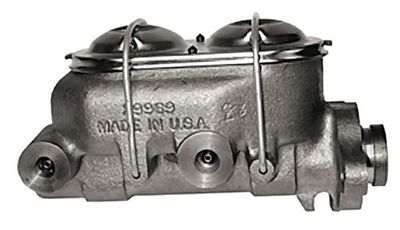
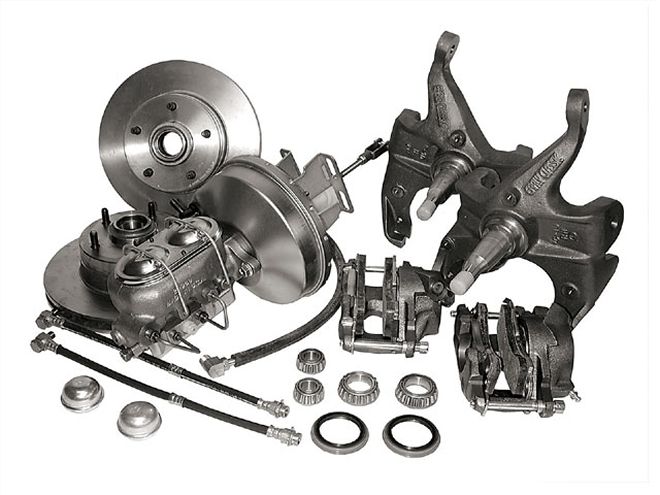
We've done a lot of brake installation stories showing how to get bigger and better brakes. Unfortunately we tend to forget at times that even with the latest high-dollar brake systems, if you don't understand the basics of how the whole system is suppose to work, you just might be driving around in circles with a system that's not living up to its potential. Too often people suffer through poor-performing mods because they just think that the parts didn't live up to the hype, when in reality with a little tweaking and troubleshooting, the components can do more for them than they may have even hoped.
We decided to take a step back and explore the most important part of your hot rod. We got together with the crew at Master Power Brakes along with some others to harness some of their vast knowledge on the subject. We walked away with more than we expected. So much so, in fact, that we had to break the story into two parts (the next to follow next month).
In this issue we'll go over the basics of master cylinders, power boosters, calipers, and the required valves to make it all work right. We also asked and answered some of the more common questions, and learned a thing or two. We hope you will too.
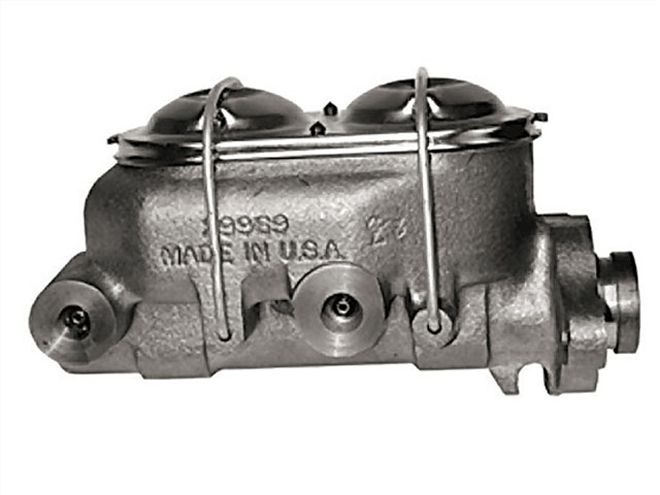
Master Cylinder Types
The master cylinder is the heart of the braking system. In order for the system to function properly, the correct cylinder must be utilized for the system's demands. The following brief descriptions will help explain why you need a specific type for each brake combo.
Drum/Drum
A drum/drum master is designed to deliver fluid pressure and volume to the front and the rear of a braking system in equal proportions. Drum brakes will require less fluid and pressure than disc brakes. Typically, a drum brake master will be smaller than a disc master and the fluid reservoir chambers will be equal in size. Because drum brakes require the use of residual pressure valves, the original drum master cylinders had residual valves built into the outlets. Later model aftermarket units do not have these valves and they must be installed in the lines externally. Failure to incorporate residual valves will cause spongy brakes.
Generally speaking, it's not a good idea to use a drum brake master for disc brakes since the amount of fluid the cylinder pushes will not be sufficient.
Disc/Drum
A disc/drum master is designed to push more fluid volume to the front disc brakes because disc brakes require more volume than drum brakes. Generally, a disc/drum master will have one fluid reservoir larger than the other. This is because the disc brake pads wear faster than the drum shoes and the fluid reservoir will drop faster. Original disc/drum masters had a built-in residual pressure valve to the rear drum brakes only.
Never reverse the outlets on a disc/drum master. Doing this will cause the front disc brakes to drag excessively from the residual pressure valve.
Disc/Disc
A four-wheel disc brake master cylinder is designed to supply more fluid pressure and volume to the rear disc brakes than the disc/drum master does. This is achieved through an internal piston redesign. The piston that feeds the rear brakes on a disc/drum master will run out of stroke, limiting the amount of fluid pressure and volume that may be supplied to the rear disc brakes.
The four-wheel disc master redesign delivers the extra-needed volume and pressure to the rear, allowing your rear disc brakes to function properly. If you attempt to use a disc/drum master on a four-wheel disc system, you will get poor rear brake function and experience a spongy brake pedal with a long pedal travel.
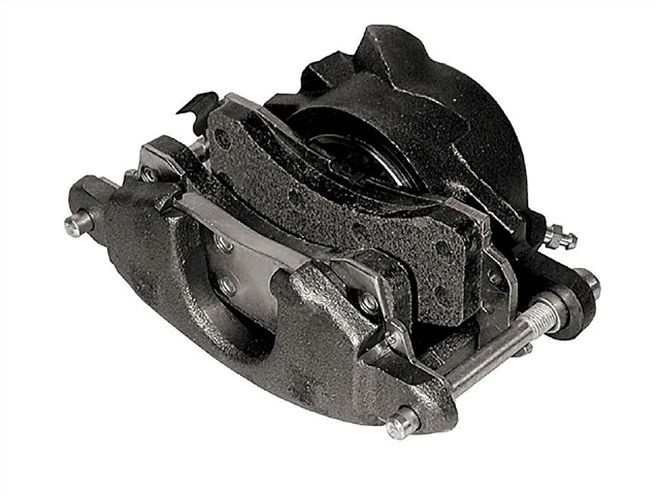
Brake Systems
Single Piston
Single-piston calipers have been the braking standard for the past 30 years. The single-piston caliper system performs well for most applications. With the single-piston caliper design the disc brake rotor is squeezed between a pad that is stationary on one side and a pad that is moved by the caliper piston. The advantage of this design is that it is simple and is not prone to leaking or failure.The most common single-piston caliper kit utilizes an 11-inch rotor that is perfect for most street applications. After all, if GM and Ford used this design for 30 years without change, it has to be good.
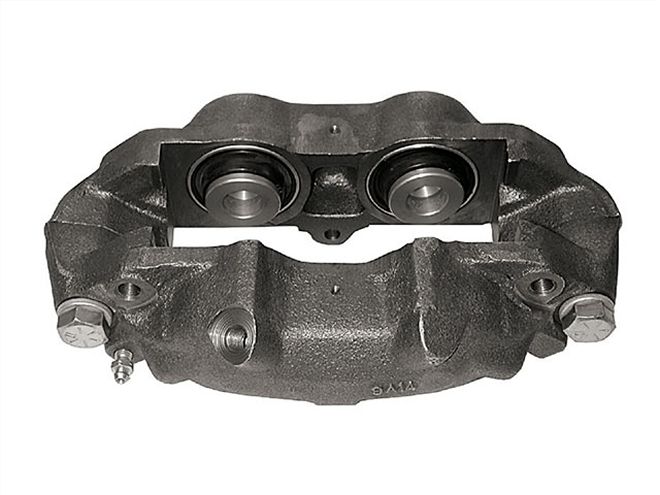
Four Piston
The four-piston caliper disc brake system was the original disc brake design used by the Big Three-GM, Ford, and Chrysler. Although beautifully designed, this system had one major weakness ... four-caliper pistons had four times the chance of leaking or failure. Long-term function without failure was the driving force to go to the single-piston caliper design.
The advantage of this system is the caliper is prone to less flexing under stress, which in turn keeps the pads more even on the rotor, producing more friction.
Today, the leaking problem can be eliminated or at least severely reduced by having the piston bores of the caliper sleeved with stainless steel. This eliminates bore corrosion, which leads to leaking.
Rotor Size
Efficient braking requires the conversion of your hot rod or custom's kinetic energy into heat. The rotor being clamped by the disc brake pads produces this heat. The rapid dissipation of this generated heat is critical to good brake function. The larger the rotor, the more efficiently it will dissipate heat, which translates into better braking.
For most street applications, an 11-inch rotor will work perfectly. However, a heavy custom or a rod that's subjected to extreme braking will benefit from 12-inch rotors.
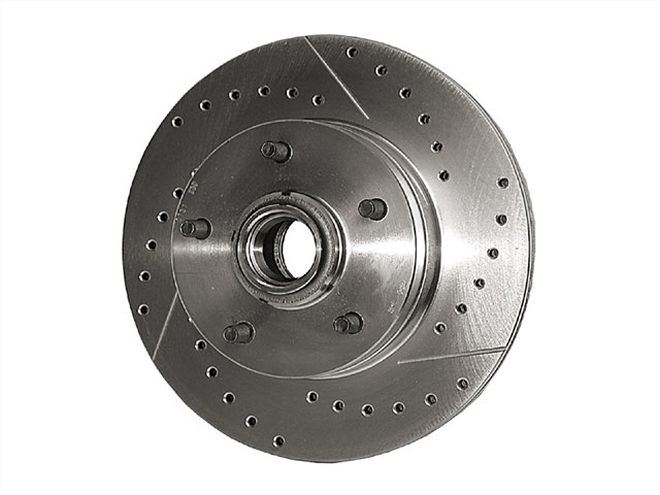
Cross-Drilled Rotors
Better braking performance is all about cooling down the rotor fast. When a rotor is cross-drilled or slotted this helps to discharge the hot gasses that are built up and therefore cool down the rotor faster. Hence, better braking. Although cross-drilled and slotted rotors are not an absolute necessity for street use they are a relatively inexpensive upgrade when adding disc brakes, and let's face it, they look cool.
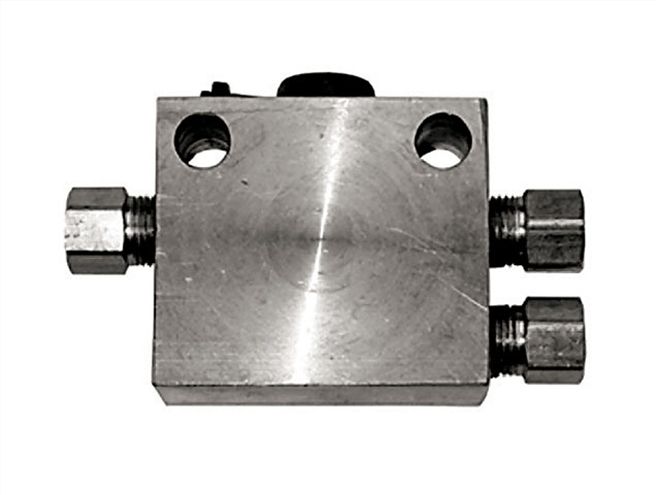
Metering Valves
Metering Valve
The metering or hold off valve is used in the brake system to better balance the front to rear brakes. The valve does not allow the pressure to rise at the front disc brakes until the pressure at the rear drums has risen sufficiently to overcome the brake shoe springs. At this point the valve opens to allow full pressure to build at the front brakes. This provides rear stability on wet surfaces and reduces excessive pad wear.
Proportioning Valve
The proportioning valve modulates the pressure to the rear brakes. The modulation is necessary to minimize rear wheel lock up found in heavy braking and to compensate for the differences in braking conditions in front disc/rear drum systems. As pressure is applied to the system, full pressure is allowed to the rear drums up to a certain point. Beyond that point the pressure to the rear is reduced, preventing rear brake lock up.
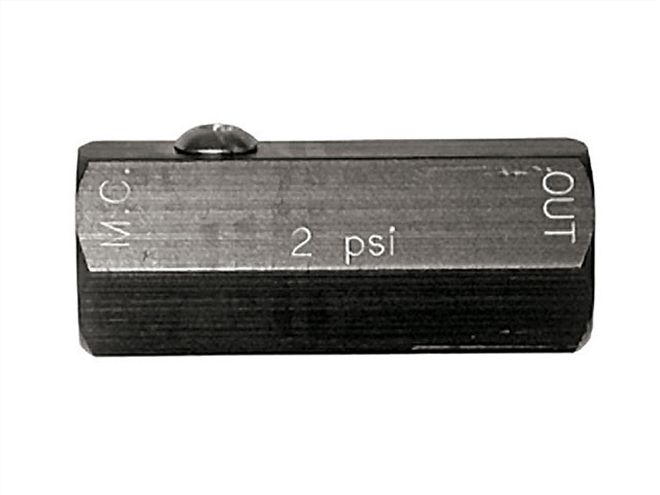
Residual Valve
There are two different residual valves. A 10-lb residual valve will maintain line pressure to the rear to keep the drum brake shoes out close to the drums, resulting in a higher, firmer pedal. Without a 10-lb residual pressure to the rear you will experience a spongy pedal. A 2-lb residual valve is required to prevent backflow of fluid from the calipers to the master whenever the master cylinder is lower (usually mounted on the frame) than the calipers.
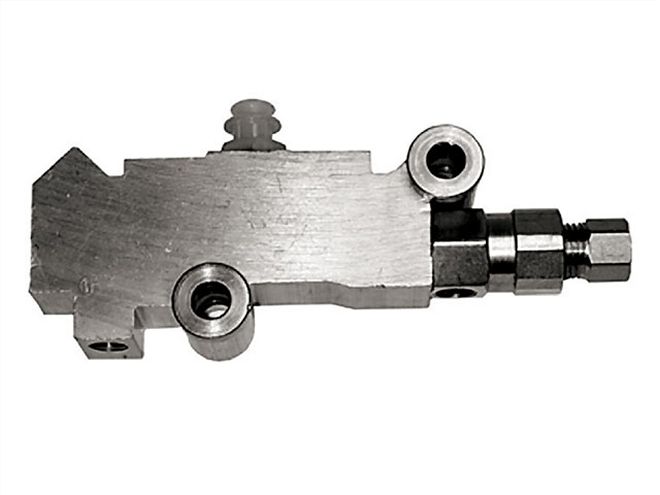
Combination Valve
A combination valve incorporates metering and proportioning and sometimes residual into one valve. These are available for disc/drum or drum/drum systems. Many companies supply a later model combination valve that incorporates all three valves with their kits.
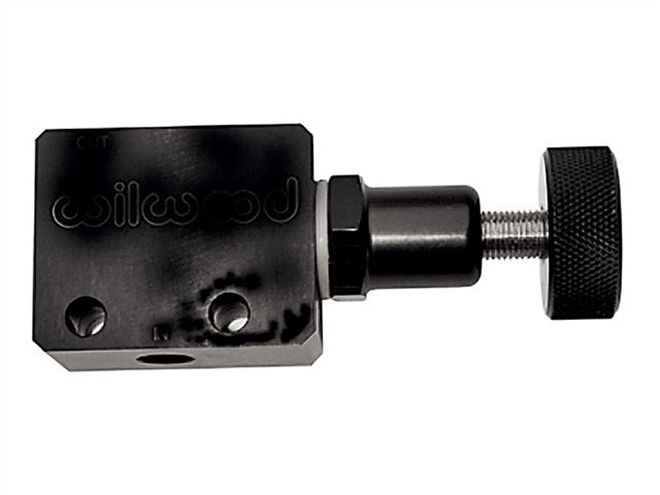
Adjustable Prop Valve
The adjustable proportioning valve is used when you have a special rear condition that requires higher or lower pressure than a normal condition. You should always use a metering valve to the front when using the adjustable proportioning valve.
Is Power Really Necessary?
The addition of disc brakes does not require the need of a power booster. Manual disc brakes work fine, but a power booster just gives that nice, easy pedal feel that newer cars have.
Most street applications will work fine with a 9-inch single diaphragm power booster. Very heavy vehicles will require a larger booster. For valve cover clearance and four-wheel disc brakes an 8-inch dual diaphragm booster works quite well. For lighter weight vehicles, like Model As, a 7-inch booster will work fine for disc/drum setups. For a four-wheel disc system or a heavier custom a 7-inch booster will not give enough assist, and an 8-inch dual diaphragm booster is the way to go.
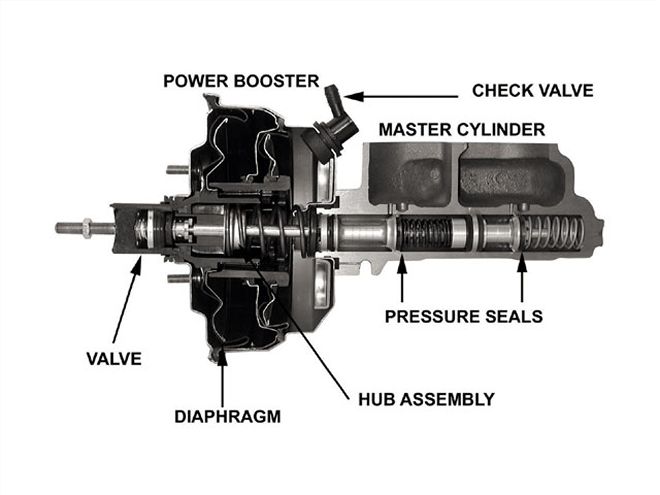
How Does A Booster Work?
A power booster uses atmospheric pressure to help assist the pushing of the master cylinder piston. Basically, a power booster is divided into two chambers internally with a rubber diaphragm separating each. With no force applied to the booster there will be a vacuum on both sides of the diaphragm. This vacuum is supplied by the engine either from the intake manifold or the back of the carburetor.
When you press on the pedal, the rod opens a poppit valve in the booster that allows atmospheric pressure on the firewall side of the diaphragm. This causes the diaphragm to push on the master cylinder piston through a plastic hub, providing power assist to the master cylinder.
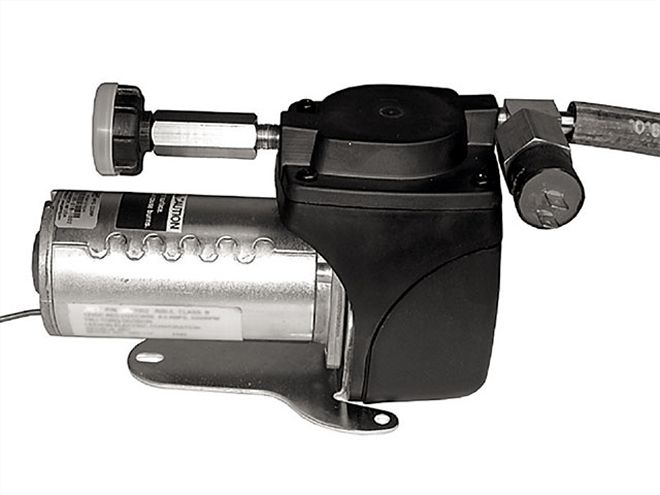
Pedal Ratio
Here are few things to remember when setting up a pedal for manual brakes.
1.Always use a pedal ratio of 5:1 or higher for manual brakes.
2. If your pedal ratio is 5:1 use a 1-inch bore master. Anything larger will result in a hard pedal and low pressure.
3. If you wish to use a larger 1 1/8-inch bore master, your pedal ratio should be around 6:1.
4. The smaller the bore the more pressure output at the expense of pedal travel.
5. If your calipers are large or you have four-wheel disc brakes, you should use a 1 1/8-inch bore master to reduce pedal travel.
Master Cylinder Q&A
Q.How does a disc brake master differ from a drum brake master?
A.A drum brake master will differ from a disc brake master in two ways. The amount of fluid that a drum brake master has to move is less than a disc brake. Drum brake masters have 10-lb residual valves at the outlet to keep a residual pressure on the drums. If you use a drum brake master for disc brakes, you would move an insufficient volume of fluid and the disc brakes would drag because of the residual valves.
Q.What will happen if I use a master cylinder for drum brakes and it doesn't have a residual valve?
A. You will have a spongy pedal and you'll have to pump the pedal to get good brakes.
Q.I have manual brakes and I have an extremely hard pedal. Why?
A.Check the bore size of your master cylinder. If it is larger than 1 inch, then you'll have a very hard pedal.
Q.What bore size do you need for manual brakes?
A.If you use anything larger than 1 inch, then you will have an extremely hard pedal. The smaller the bore the more pressure that is output to the wheels.
Q.What is the difference between a power brake master and a manual brake master?
A. A power brake master will have a larger bore diameter than a manual master.
Q.Can I use my manual master on a booster?
AYes
Q.Can I use a power brake master without a booster?
A.Usually not. The bore size will be too large, resulting in a hard pedal, and the piston hole will be shallow, allowing the push rod to fall out.
Q.Should I buy a rebuilt or new master?
A. Always try to use a new master. Rebuilt units tend to have a high failure rate. The best way to rebuild a master is to sleeve it with stainless steel.
Q.Can I use a disc/drum master for four-wheel disc brakes? A. Usually not. For four-wheel disc brakes to function properly you will need a master that has a longer stroke.
Q.How can I tell if my master cylinder is bad?
A.You will have very spongy brakes. Also, when you hold your foot on the brake pedal it will sink slowly toward the floor.
Q.Why should I eliminate my single piston master?
A. Safety. By going to a split system the possibility of a complete brake failure is virtually eliminated.
Q.Can I rebuild a master myself?
A. Yes, but you must have the correct rebuilding kit. Also, check the bore to be sure it is not pitted or corroded.
Q.I purchased a replacement master and it does not look like the original. Can I use it?
A.Probably yes. Many aftermarket replacement masters will have a different casting look but be the same internally.
Power Booster Q&A
Q. What are the symptoms of a bad power booster?
A. A bad power booster will give a very hard pedal, and it will feel like you need two feet to stop the car.
Q. How much pressure should I be getting to the wheels with a power booster?
A. Typically you should expect about 1,000 psi to the wheels for a disc brake system. A disc brake system requires this amount of pressure so be careful when using a smaller 7-inch booster that puts out only 900 psi pressure.
Q. Can I use a Ford booster on a GM vehicle?A. If you can mount the booster properly and link it to the pedal then any manufacturer's booster can be used on any type of car.
Q. How much vacuum is needed to operate a booster properly?
A. For a power booster to function properly you will need at least 18 inches of vacuum. Anything lower will give you a hard pedal
Q. I have power drum brakes. Can I use the same booster if I change to disc brakes?
A. Yes. Just be sure to use a disc brake master cylinder.
Q. What happens if the vacuum is too low?
A. If your vacuum level is too low you will experience a hard pedal and it will feel like the vehicle won't stop.
Q. I have a radical cam. Is there any way to supplement my low engine vacuum?
A. Yes. You'll need an electric vacuum pump that works off the 12-volt system and gives a 21-inch vacuum.Q. Will a reserve canister help?
A. Somewhat, but usually they will only show a moderate increase in braking performance because the engine doesn't really get to a sufficient vacuum level on a constant basis. You really need a constant 18 inches at least.
Q. What are my options if I don't want to use the vacuum pump?
A. Not many. Without the supplemental pump the only choice is to eliminate the booster and go to manual brakes.
Q. How do I check to see if my booster is operating properly?
A. Shut off the engine. Depress the brake pedal a few times to evacuate the booster. Apply steady pressure to the pedal and start the engine. The pedal should fall slightly.
Q. Is there any way to decrease booster size and still maintain assist?
A. Yes. By using a dual diaphragm design booster you can maintain a high level of assist while keeping a small size. An 8-inch dual diaphragm booster will fit most street rod and GM applications.
Q. Will I need a special booster with four-wheel disc brakes?
A. The main consideration with four-wheel disc brakes is that you have plenty of power assist-don't undersize your booster.
Q. When I step on the brakes the pedal feels good but I get no braking. What could cause this?
A. One of the causes is a mismatch between the booster pin length and the depth of the master cylinder piston hole. Be sure the hole is not too deep for the booster pin.
Q. I have installed a new booster on my car and now the brakes drag.
A. Again, this can be caused by a mismatch between the booster pin and the master cylinder piston. Too long of a pin will cause this.
Q. I upgraded my manual brakes to power brakes and now they're extremely sensitive.
A. The most likely cause is the pedal ratio is wrong. There are two attachment points on the brake pedal. For power brakes you need to use the lower attachment hole. Using the upper hole will make the brakes too sensitive.
Q. Why do power boosters keep going bad on my car?
A. You are probably getting corrosive vapors back into the booster. Install a vapor trap and that should eliminate the problem.
Q. Can I rebuild my own booster?
A. This is not a good idea. There are many parts inside the booster that will require special tools to assemble and re-assemble.
THE EFFECT OF PEDAL RATIO AND BORE SIZE